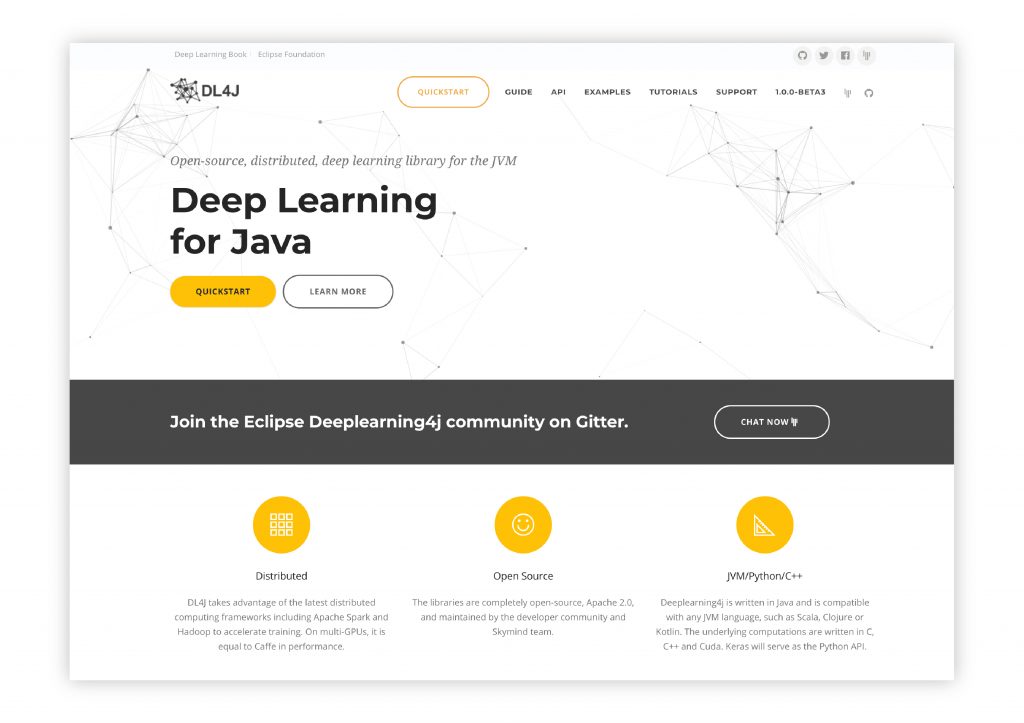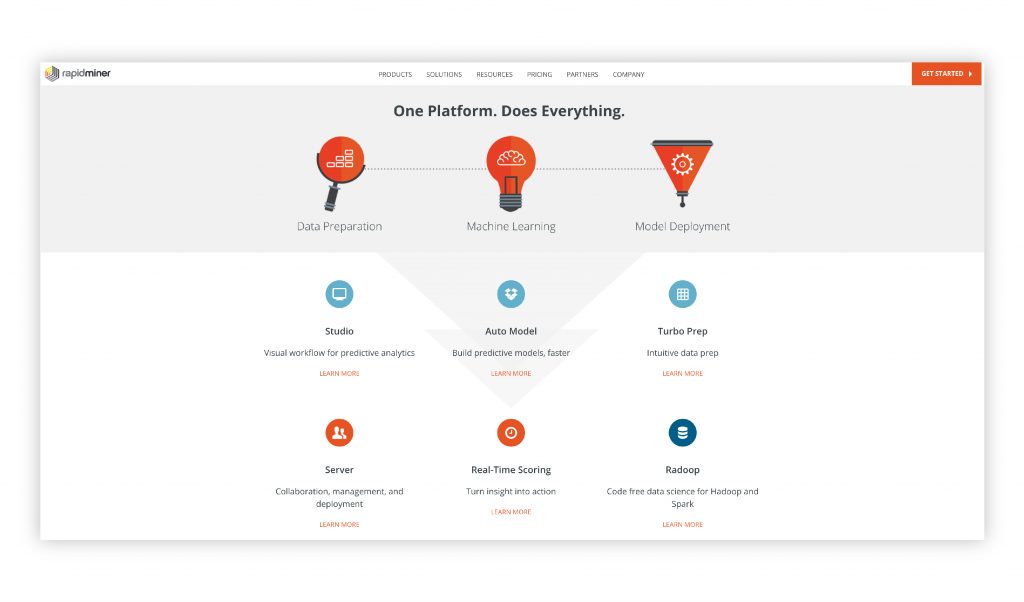Top 10 Java Machine Learning Tools and Libraries

Virtual personal assistants and other progressive technologies rely on advances in Artificial Intelligence. The most popular AI fields are natural language processing, machine learning, and deep learning. Big companies employ them in activities ranging from online advertising targeting to self-driving cars. Consequently, ML experts are in demand, and ML and deep learning are some of the hottest skills currently. The number of tools that simplify the programmers’ work is growing too.
This article is intended not only for Java web developers. Business owners need to know whether a programmer can develop ML applications efficiently, which includes familiarity with machine learning packages in Java. Moreover, if you have a say in the tech stack discussions, it’s useful to know the context.
The focus on Java machine learning reflects the popularity of the language. Due to its extreme stability, leading organizations and enterprises have been adopting Java for decades. It’s widely used in mobile app development for Android which serves billions of users worldwide.
For implementing machine learning algorithms Java developers can utilize various tools and libraries. At least 90 Java-based ML projects are listed on MLOSS.org alone. This article features ten most commonly used libraries and platforms; it briefly describes the kind of problems they can solve and the algorithms they support.
Key Java Machine Learning Tools & Libraries (Alphabetical Order)
Apache Spark’s MLib
Apache Spark is a platform for large-scale data processing built atop Hadoop. Spark’s module MLlib is a scalable machine learning library. Written in Scala, MLib is usable in Java, Python, R, and Scala. MLlib can be easily plugged into Hadoop workflows and use both Hadoop-based data sources and local files. The supported algorithms include classification, regression, collaborative filtering, clustering, dimensionality reduction, and optimization.
Deep Learning for Java
Deeplearning4j, or DL4J, is our favorite. It’s the first commercial-grade, open-source distributed deep learning library written in Java. DL4J is compatible with other JVM languages, e.g., Scala, Clojure, or Kotlin. Integrated with Hadoop and Spark, it’s meant to be a DIY tool for the programmers.

The mission of DL4J is to bring deep neural networks and deep reinforcement learning together for business environments rather than research. DL4J provides API for neural network creation and supports various neural network structures: feedforward neural networks, RBM, convolutional neural nets, deep belief networks, autoencoders, etc. Deep neural networks and deep reinforcement learning are capable of pattern recognition and goal-oriented ML. Hence, DL4J is useful for identifying patterns and sentiment in speech, sound and text, detecting anomalies in time series data, e.g., financial transactions, and identifying faces/voices, spam or e-commerce fraud.
ELKI
ELKI stands for the Environment for Developing KDD-Applications Supported by Index Structures. The open source data mining software is written in Java. It is designed for researchers and is often used by graduate students looking to create a sensible database.
ELKI aims at providing a variety of highly configurable algorithm parameters. The separation of data mining algorithms and data management tasks for the independent evaluation of the two is unique among data mining frameworks. For high performance and scalability, ELKI offers R*-tree and other data index structures that can provide significant performance gains. ELKI is open to arbitrary data types, file formats, or distance or similarity measures.
Java-ML
Java-ML (Java Machine Learning Library) is an open source Java framework/Java API aimed at software engineers, programmers, and scientists. The vast collection of machine learning and data mining algorithms contains algorithms for data preprocessing, feature selection, classification, and clustering. When compared with other clustering algorithms, it is straightforward and allows for easy implementation of any new algorithm. There’s no GUI, but algorithms of the same type have a clear common interface.
Java-ML supports files of any type, provided that it contains one data sample per line, and that a comma, semicolon or tab separates the features. Java-ML has well-documented source code and plenty of code samples and tutorials.
JSAT
JSAT stands for Java Statistical Analysis Tool. It has one of the largest collections of machine learning algorithms. JSAT is pure Java and has no external dependencies. Part of the library was intended for self-education, and thus all code is self-contained. Much of it supports parallel execution. The library is suitably fast for small and medium-size problems.
Mahout
Apache Mahout is a distributed linear algebra framework and mathematically expressive Scala DSL. The software is written in Java and Scala and is suitable for mathematicians, statisticians, data scientists, and analytics professionals. Built-in machine learning algorithms facilitate easier and faster implementation of new ones.
Mahout is built atop scalable distributed architectures. It uses the MapReduce approach for processing and generating datasets with a parallel, distributed algorithm utilizing a cluster of servers. Mahout features console interface and Java API to scalable algorithms for clustering, classification, and collaborative filtering. Apache Spark is the recommended out-of-the-box distributed back-end, but Mahout supports multiple distributed backends.
Mahout is business-ready and useful for solving three types of problems:
1. item recommendation, for example, in a recommendation system;
2. clustering, e.g., to make groups of topically-related documents;
3. classification, e.g., learning which topic to assign to an unlabeled document.
MALLET
Machine Learning for Language Toolkit is an extensive open source library of natural language processing algorithms and utilities. It features a command-line interface. There’s Java API for naïve Bayes, decision trees, maximum-entropy and hidden Markov models, latent Dirichlet topic models, conditional random fields, etc.
This Java-based package supports statistical NLP, document classification, clustering, cluster analysis, information extraction, topic modeling, and other ML applications to text. MALLET’s sophisticated tools for document classification include efficient routines for converting text to “features.” Tools for sequence tagging facilitate named-entity extraction from text. GRMM, an add-on package to MALLET, contains support for inference in general graphical models, and training of CRFs with arbitrary graphical structure.
MOA
Massive Online Analysis is the most popular open source framework for data stream mining. MOA is used specifically for machine learning and data mining on data streams in real time. Its Java machine learning algorithms and tools for evaluation are useful for classification, regression, clustering, outlier detection, concept drift detection, and recommendation systems. The framework can be useful for large evolving datasets and data streams, as well as data produced by IoT devices.
MOA provides a benchmark framework for running experiments in the data mining field. Its useful features include:
- extendable framework for new mining algorithms, new stream generators, and evaluation measures;
- storable settings for data streams for repeatable experiments;
- set of existing algorithms and measures from the literature for comparison.
RapidMiner
The commercial data science platform was built for analytics teams. It’s currently powering Cisco, GE, Hitachi, SalesForce, Samsung, Siemens, and other giants. It comes with a set of features and tools to simplify the tasks performed by data scientists, to build new data mining processes, to set up predictive analysis, and more. Constructing understandable and straightforward machine learning workflows becomes easy. Automated ML speeds up and simplifies data science projects. Add to that a big community and extensive documentation.

RapidMiner works throughout the data science lifecycle, from data prep to predictive model deployment. The data science platform includes a lot of ML libraries and algorithms through GUI and Java API for developing own applications. Data scientists can leverage features selection, data loading and cleaning with GUI, create visual workflows, simplify model deployment and management, implement code-free data science, and more.
Weka
Last but not least, the open-source Weka is arguably the most well-known and popular machine learning library for Java. The general-purpose library features a rich graphical user interface, command-line interface, and Java API. It’s free, portable, and easy to use.
Weka’s machine learning algorithms for data mining tasks can be applied directly to the dataset, through the provided GUI, or called from your Java code through the provided API. There are tools for data preparation, classification, regression, clustering, association rules mining, time series prediction, feature selection, anomaly detection, and visualization. Weka has advanced features for setting up long-running mining runs, experimenting and comparing various algorithms. It lets you run learning algorithms on text files.
Weka’s primary uses are data mining, data analysis, and predictive modeling. Applications that require automatic classification of data are the primary beneficiaries. It is also well-suited for developing new ML schemes.
TL;DR

This article lists ten popular Java AI frameworks, most of them open source. The choice of a framework mainly depends upon the support for algorithms and implementation of neural networks. Speed, dataset size, and ease of use are other factors that often affect decision making. What’s most important when choosing a Java machine learning library is to understand your project requirements and the problems you intend to solve.
For example, MALLET supports statistical natural language processing and is useful for analyzing massive collections of text. RapidMiner provides data handling, visualization, and modeling with machine learning algorithms. Its products are used by 450,000+ professionals to drive revenue, reduce costs, and avoid risks.
JSAT is arguably one of the fastest Java machine learning libraries. It provides high performance, flexibility, and opportunity for quickly getting started with ML problems. Apache Spark’s MLib is also known to be powerful and fast when it comes to the processing of large-scale data. Deeplearning4j is considered one of the best because it takes advantage of the latest distributed computing frameworks to accelerate training. Mahout offers high performance, flexibility, and scalability.
Weka is probably the best Java machine learning library out there. The vast collection of algorithms and tools for data analysis and predictive modeling has implementations of most of ML algorithms. Related to the Weka project, MOA performs big data stream mining in real time and large-scale ML. MOA aims for time- and memory-efficient processing. Compared to Weka, Java-ML offers more consistent interfaces. It has an extensive set of state-of-the-art similarity measures and feature-selection techniques. There are implementations of novel algorithms that are not present in other packages. Java-ML also features several Weka bridges to access Weka’s algorithms directly through the Java-ML API.
Although non-exhaustive, the list of Java machine learning libraries hopefully will be useful when you are about to design, build, and deploy an ML application. Contact us if you need professional help!
Content created by our partner, Onix-systems.
 Home
Home